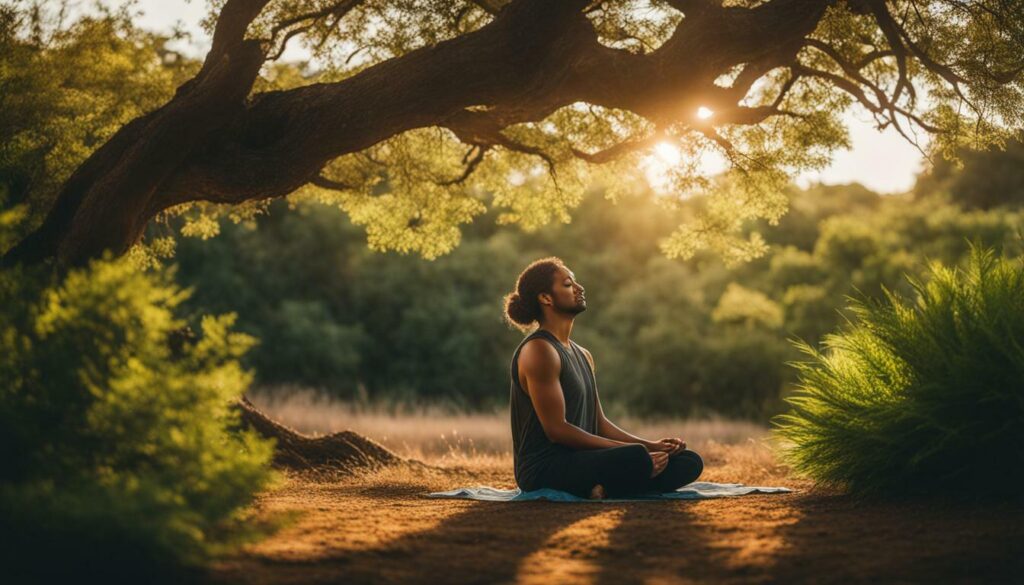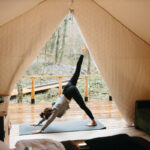Our website is supported by our readers. We sometimes earn affiliate commissions when you click through the affiliate links on our website at no extra cost to you.
Slow living is a mindset and lifestyle that encourages individuals to curate a more meaningful and conscious way of living. It emphasizes doing things at the right speed and prioritizing the things that matter most.
Slow living is not about doing everything slowly, but about being present and intentional. It is not limited to those who live in the country and does not mean going tech-free. Embracing slow living can lead to benefits such as having more time for self-care, being more present, building stronger relationships, reducing environmental impact, finding fulfillment and purpose, and connecting with nature.
Key Takeaways:
- Slow living encourages a more meaningful and conscious way of living.
- It is about being present, intentional, and prioritizing what matters most.
- Slow living is not limited to specific settings or going tech-free.
- Embracing slow living can lead to benefits such as self-care, stronger relationships, and connection with nature.
The Origins of Slow Living
The slow living movement traces its roots back to the 1980s in Italy, with the formation of Slow Food, which emphasized the importance of savoring meals and connecting with local ingredients. Inspired by the slow food philosophy, the concept of slow living expanded to encompass all aspects of life. It encourages individuals to take a step back from the fast-paced, multitasking culture and embrace a more intentional and mindful approach to living.
Embracing Slow Living: Mindfulness and Simplicity
“Slow living means structuring your life around meaning and fulfillment rather than the accumulation of things.” – Carl Honoré
Mindfulness and simplicity are at the heart of slow living. By practicing mindfulness, we can cultivate a deeper awareness and appreciation of the present moment. It involves paying attention to our thoughts, emotions, and physical sensations without judgment. When we embrace simplicity, we let go of unnecessary complexity and focus on what truly brings us joy and fulfillment.
Slow living encourages us to savor the little moments and create a more balanced and meaningful life. It invites us to step off the relentless treadmill of busyness and connect with ourselves, others, and the world around us in a more intentional and mindful way.

Slow living is a powerful antidote to the fast-paced, consumer-driven culture that often leaves us feeling overwhelmed and disconnected. It is a call to embrace a more deliberate and conscious way of living, where we take the time to slow down, reflect, and appreciate the beauty and richness of life.
By embracing slow living, we can create a more sustainable, fulfilling, and meaningful life for ourselves and future generations.
Redefining Priorities: Embracing a Balanced Life
In our modern society, the frantic pace of life often leaves little room for relaxation and self-care, but embracing slow living allows us to rediscover the beauty of balance. It allows us to reevaluate our priorities and find a harmonious rhythm that nourishes our mind, body, and soul.
Stress reduction is a key benefit of embracing slow living. By consciously slowing down, we create space to unwind, reflect, and recharge. This helps us better manage stress and prevent burnout.
Another important aspect of slow living is achieving a healthy work-life balance. It’s easy to feel overwhelmed by work responsibilities and neglect our personal needs. By embracing slow living, we set boundaries to ensure we have time for rest, relaxation, and activities that bring us fulfillment. This not only improves our overall well-being but also enhances our productivity and creativity in the long run.
Practical Tips for Embracing Slow Living:
- Practice being present: Engage fully in each moment, savoring the experiences and letting go of distractions.
- Create space in your day: Schedule breaks between tasks to recharge and reflect. Take moments to breathe deeply and be mindful of your surroundings.
- Adopt a slow information diet: Limit your exposure to news and social media, focusing on quality content that adds value to your life.
- Say no to nonessentials: Prioritize activities and commitments that align with your values and bring you joy, learning to decline requests that don’t serve your well-being.
- Put life before work: Set boundaries and establish a healthy work-life balance. Dedicate time to activities that bring you happiness and fulfillment outside of work.
- Get outside and connect mentally: Spend time in nature, allowing its beauty and tranquility to recharge your mind and soul. Practice mindfulness while immersing yourself in the natural world.
- Find inspiration in the slow living community: Seek out resources, podcasts, books, and TED Talks that align with the principles of slow living. Connect with like-minded individuals who value conscious, intentional living.
Embracing slow living is a journey, and it may look different for each individual. The key is to make choices that align with your values and promote a more balanced and intentional life.

Slow living encourages us to simplify our lives, let go of unnecessary clutter.
Minimalism plays a key role in slow living, as it allows us to declutter our physical and mental spaces. By letting go of material possessions that no longer serve us, we create room for what brings us joy and value. It is a process of evaluating our belongings and embracing a mindset of quality over quantity.
Embracing Simplicity and Mindfulness in Daily Life
- Create a minimalist living space by decluttering and organizing your belongings.
- Simplify your daily routines by focusing on the essential tasks and letting go of unnecessary commitments.
- Practice gratitude by taking time each day to appreciate the simple pleasures and blessings in your life.
- Engage in mindfulness activities, such as meditation or yoga, to cultivate a deeper sense of awareness and presence.
“The little things? The little moments? They aren’t little.” – Jon Kabat-Zinn

By embracing simplicity and mindfulness, we can align our actions with our values and discover a greater sense of fulfillment and purpose. Slow living empowers us to create a life that is intentional, balanced, and full of meaning. Let’s embrace the beauty of simplicity and mindfulness, and unlock the full potential of slow living.
Connecting with Nature: Finding Peace and Sustainability
Slow living invites us to reconnect with nature, to find solace in the beauty of the natural world and to contribute to a more sustainable future. In our fast-paced lives, it’s easy to become disconnected from the environment and the impact we have on it. However, we can foster a deeper connection with nature and make conscious choices that promote sustainability.
Spending time in nature has been proven to reduce stress levels, improve mental well-being, and increase overall happiness. Whether it’s taking a leisurely walk in the park, hiking through the mountains, or simply sitting under a tree and basking in the tranquility, nature has the power to restore and rejuvenate our souls. It reminds us of the simplicity and beauty that surrounds us.
“In every walk with nature, one receives far more than he seeks.” – John Muir
Connecting with nature also motivates us to live more sustainably. As we immerse ourselves in the wonders of the natural world, we become more aware of the urgent need to protect and preserve it. We start making conscious choices that reduce our environmental impact, such as reducing single-use plastic, conserving energy and water, supporting local and sustainable businesses, and practicing eco-friendly habits.
Reconnecting with nature in daily life:
- Spend time outdoors regularly, even if it’s just a few minutes in your garden or a nearby park.
- Practice mindfulness in nature by engaging all your senses and being fully present in the moment.
- Participate in outdoor activities that align with your interests, such as gardening, birdwatching, or nature photography.
- Support initiatives and organizations that work towards environmental conservation and sustainability.

By reconnecting with nature, we not only find peace and solace in our own lives, but also contribute to the well-being of the planet. So, take a moment to step outside, breathe in the fresh air, and let the beauty of nature inspire and guide you.
Nurturing Relationships: Building Stronger Connections
By slowing down and being present, we can invest more time and energy into our relationships, creating a solid foundation of love, trust, and support. In today’s fast-paced world, it’s easy to neglect the people who matter most to us. But by embracing slow living, we can prioritize our relationships and foster deeper connections.
Creating Quality Time
- Set aside dedicated time for loved ones, free from distractions and obligations.
- Engage in activities that encourage connection, such as cooking together or going for a nature walk.
- Practice active listening, making an effort to understand and empathize with the other person’s perspective.
- Express gratitude and appreciation for the people in your life, acknowledging their importance and impact.
By nurturing our relationships, we not only strengthen the bond we have with others but also enhance our own well-being. Research has shown that meaningful connections and social support contribute to improved mental and physical health. When we feel connected and supported, we experience less stress and greater happiness.

“In the rush of everyday life, we often forget to prioritize our relationships. Slow living reminds us to slow down, be present, and invest in the people who bring joy and meaning to our lives.” – Jane Doe
The Slow Living Community: Resources and Inspiration
For those seeking guidance and inspiration on their slow living journey, there is a wealth of resources available, including books, podcasts, and TED Talks, that can offer valuable insights and practical tips.
Books:
- Slow: Simple Living for a Frantic World by Brooke McAlary
- The Art of Simple Living: 100 Daily Practices from a Japanese Zen Monk for a Lifetime of Calm and Joy by Shunmyo Masuno
- Essentialism: The Disciplined Pursuit of Less by Greg McKeown
Podcasts:
- The Slow Home Podcast – Hosted by Brooke McAlary, this podcast explores the power of slow living and offers practical advice on how to simplify your life.
- The Minimalists Podcast – Joshua Fields Millburn and Ryan Nicodemus discuss minimalism as a way to live a more intentional and fulfilling life.
TED Talks:
- Want to be Happy? Be Grateful by David Steindl-Rast – This inspiring talk explores the connection between gratitude and happiness.
- Less Stuff, More Happiness by Graham Hill – Graham Hill shares his journey toward minimalism and how it has brought him more joy and fulfillment.

Embracing Slow Living: Practical Tips and Strategies
Embracing slow living doesn’t have to be overwhelming. By implementing small changes and adopting mindful practices, you can gradually transform your life to prioritize what truly matters. Here are some practical tips and strategies to help you embrace the living slow lifestyle:
1. Understand Busyness and Make Conscious Choices
Take a step back and evaluate your daily routines and obligations. Identify areas where you can simplify or eliminate tasks that don’t align with your values or bring you joy. By consciously choosing how you spend your time and energy, you can create more room for what truly matters to you.
2. Practice Being Present and Creating Space
Set aside a designated time each day to be fully present and engaged in the moment. Whether it’s through meditation, mindful breathing, or simply taking a walk in nature, giving yourself space to disconnect from distractions and fully immerse in the present can help cultivate a sense of calm and clarity.
3. Adopt a Slow Information Diet
In today’s digital age, we are constantly bombarded with information and notifications. Protect your mental well-being by intentionally limiting the amount of time you spend consuming news and social media. Focus on quality over quantity, seeking out sources of inspiration and knowledge that truly add value to your life.

4. Get Outside and Connect Mentally
Spending time in nature has been proven to reduce stress, increase creativity, and boost overall well-being. Make it a priority to get outside regularly, whether it’s going for a hike, tending to a garden, or simply taking a moment to sit and appreciate the beauty of the natural world.
Remember, slow living is about finding balance and intention in all aspects of life. By incorporating these practical tips and strategies into your daily routine, you can create a life that is more aligned with your values, promotes well-being, and allows you to savor the moments that truly matter.
Conclusion
Slow living offers a transformative approach to life, allowing us to break free from the fast-paced cycle and embrace a more intentional, mindful, and fulfilling way of living. In a world that often prioritizes productivity over well-being, slow living encourages us to slow down, savor the present moment, and focus on what truly matters.
So, let us take a deep breath, slow down, and embrace the beauty of slow living. By doing so, we can experience reduced stress, improved well-being, stronger relationships, and a greater sense of fulfillment and purpose. Slow living offers a pathway to a more meaningful and conscious existence, allowing us to truly enjoy the journey of life.
FAQ
What is slow living?
Slow living is a mindset and lifestyle that focuses on curating a more meaningful and conscious way of living. It emphasizes doing things at the right speed and prioritizing the things that matter most.
When did the slow living movement begin?
The slow living movement began in the 1980s in Italy with the formation of Slow Food, and has since expanded to other areas of life, such as work, parenting, and leisure.
Does slow living mean doing everything slowly?
No, slow living is not about doing everything slowly, but about being present and intentional.
Is slow living only for those who live in the country?
No, slow living is not limited to those who live in the country. It can be practiced in any setting and by anyone, regardless of income level.
Is slow living about going tech-free?
No, slow living does not mean going tech-free. It is about finding a balance and being intentional with technology use.
What are the benefits of embracing slow living?
Embracing slow living can lead to benefits such as having more time for self-care, being more present, building stronger relationships, reducing environmental impact, finding fulfillment and purpose, and connecting with nature.
Where can I learn more about slow living?
There are a variety of resources available to learn more about slow living, including podcasts, books, TED Talks, and speakers.
Can slow living be practiced in any setting?
Yes, slow living can be practiced in any setting. It is about living a more balanced and intentional life, with a focus on mindfulness, connection, and well-being.
What are some practical tips for embracing slow living?
To embrace slow living, you can start by understanding busyness and making conscious choices, defining a purpose and what is most important, saying no to nonessentials, practicing being present and creating space in the day, adopting a slow information diet, putting life before work, getting outside and connecting mentally, and finding inspiration in the slow living community.
What are the benefits of slow living for overall well-being?
Slow living offers numerous benefits for overall well-being, including reduced stress, improved mental and physical health, stronger relationships, increased creativity, and a greater sense of fulfillment and purpose.



